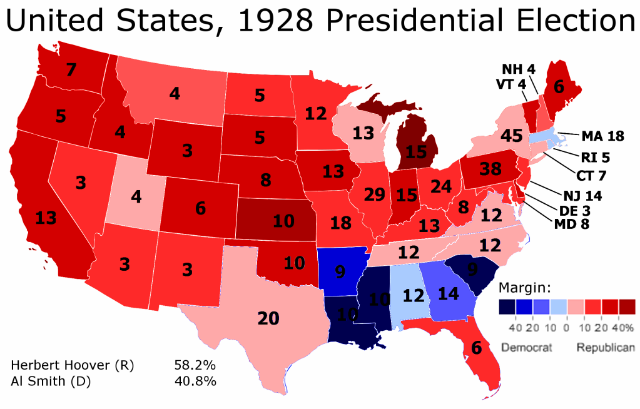Lately, frumforum.com has been on my daily internet menu. David Frum is, for obvious reasons, one of the most popular neo-con apostates among progressives. Mr. ‘axis of evil’–yeah, he’s the one that coined that term–has shown great intellectual courage over the past few years, especially since he was ejected from the Heritage Institute in the most weasley of manners. They didn’t even fire him. They just informed him that they would no longer pay him or suppply him with office space or any resources. What a bold stand they took in the face of his critical and pragmatic brand of conservatism. Now he’s marginalized, and his sphere of influence doesn’t seem likely to expand anytime soon.
Here’s a bit from this morning’s top post:
One of the effects of the Tea Party movement is to cut the Republican Party off – not only from the measured policy preferences of the American people – but from the Republican Party’s own history. It shrivels the GOP into a party without heroes, or rather a party with only one hero, Ronald Reagan, and otherwise a long succession of false and deluded leaders.
And it points Republicans to a doomed future of continuing failure and recrimination. After all, if almost every elected Republican leader of the past 100 years save Reagan fell short of conservative principle, then it seems overwhelmingly probable that the next Republican leader will also fall short of conservative principle. In which case, conservative principle has become a vehicle for guaranteeing eternal conservative disappointment and alienation. Unhealthy, no?
http://www.frumforum.com/marco…
Now, it’s obviously refreshing to hear conservatives take on the Tee Party. Frum isn’t the only one to do so. But what I find both refreshing and somewhat saddening about Frum is that he remains an unabashed conservative. He adheres to basic conservative principles but reads widely in economics and policy analysis. He conceded that the rationale behind main conservative points of opposition to marriage equality hasn’t been born out in the real world while defending the principles upon which it has been misguidedly based. On the other hand, he has failed to acknowledge how much that opposition is based on bigotry. But at least he dropped his own.
As I read his blog, mostly his own posts but other writers as well, many of them young, I get very sad. Was it really that long ago that we had sincere–as opposed to shallow and zealous–conservatives with who we could work and, more importantly debate. The agon has become agony. And it impoverishes progressivism as well as conservativism when there is such meager opportunity to give and receive critical input in a vigorous and reasonable manner. It makes clear that the Tee Party hasn’t just seized the GOP by the throat. Rather, in doing so, it is also strangling the public sphere. It’s not that I am looking for ‘common ground.’ It’s that the extended and broad symposium that public life in a democracy is supposed to foster, and upon which it depends, is being degraded, primarily by one constituency. And let’s not get into the false equivalency game. Fair-mindedness doesn’t necessitate crediting all positions and actions equally. The Tee Party has no progressive counterpart. No matter what they imagine and spin. Not MoveOn.org. Not DKos. Not the unions. Not the NOW. Not the ALCU. Not the Academy. Not any of the progressive boogie people they promote to justify their aggression as the rightful defense of persecuted victims.
My point is that we cannot reinvigorate the market place of ideas in this country from only one side. Right now, there’s a group of deranged screamers in the agora.
Perhaps the way forward for us is to stop responding to the Tee Party. They are basically attention starved and power hungry. Let’s instead reserve our responses for those conservatives with whom we can speak. Maybe we should spend more time reading and debating conservatives like Frum. That might increase his status, though I doubt it, and attract others from his side. Giving him a frequent platform on MSNBC enhances the discussions there. But it might just work against us. It’s turning him into a more intelligent version of David Brooks. Increasing traffic on FrumForum might just do something.
With such a lofty title I fear the text below will not fulfill the promise. The thoughts expressed in the comments will hopefully help us elevate this diary to that level.


 As summer comes to an end, school is just around the corner for children across the United States. For children enrolled in state schools, this typically means the return of unhealthy lunches that are best described as “fast food”: hamburgers, chicken nuggets, fried snacks, and sugary soft drinks. Yet school lunch programs can play a key role in reinforcing healthy eating behaviors by integrating such measures as school gardens, nutrition education, locally sourced organic food, and efforts that affirm the value of mealtimes.
As summer comes to an end, school is just around the corner for children across the United States. For children enrolled in state schools, this typically means the return of unhealthy lunches that are best described as “fast food”: hamburgers, chicken nuggets, fried snacks, and sugary soft drinks. Yet school lunch programs can play a key role in reinforcing healthy eating behaviors by integrating such measures as school gardens, nutrition education, locally sourced organic food, and efforts that affirm the value of mealtimes.
